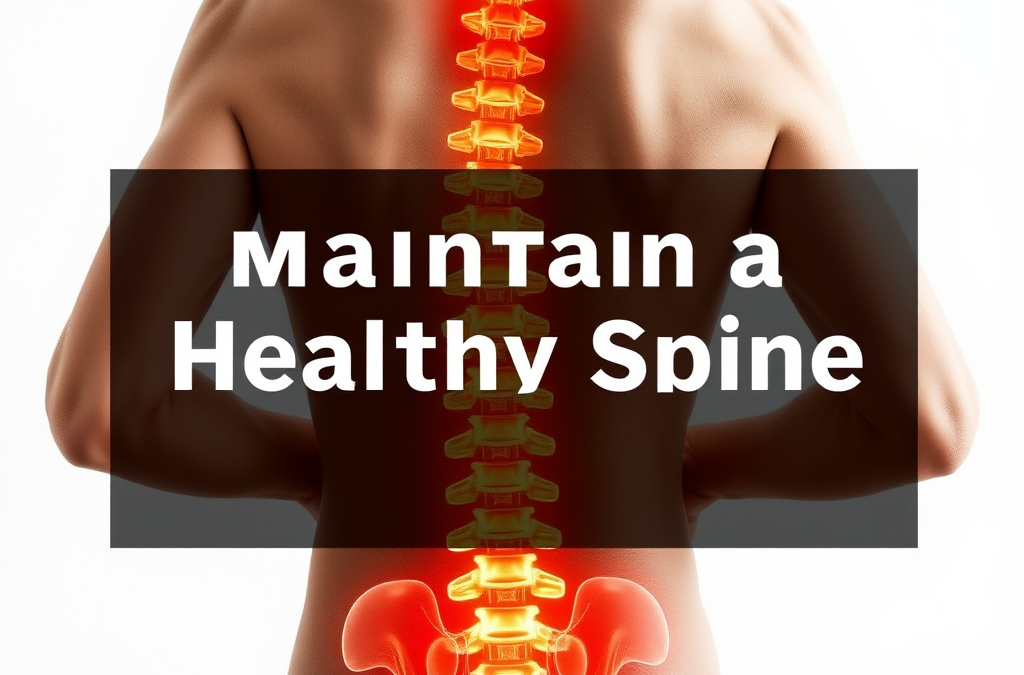Suffering from chronic back pain? 🦴 We live in an increasingly sedentary work environment, full of bad postures for long hours; one that adds to the importance of having a healthy spine. Did you know, however, that one in four people has some disc degeneration before the age of 25 and this increases to 90 percent of people by 60 years of age? This fact alone makes our visit to a chiropractor so much more urgent with the prevalence of disc degeneration increasing as we age.
Improperly caring for your spine can create more problems than mere backache; it can affect your overall health and quality of life, and it can even cause mental distress. But there is hope on the horizon. That’s right, with these simple yet impactful strategies you can finally take charge of your spinal health and say goodbye to those pesky aches and pains.
In this blog post, we will be looking at seven tips to help maintain a healthy spine – from good posture to chiropractor visits. Whether you are seeking to avoid creating problems or to relieve current pain these simple measures get you on the road to a closer, stronger, healthier spine. So come along and learn how you can turn around your spinal health! 💪
Maintain proper posture

Sit with correct alignment
Proper sitting posture is important for your spine health. To achieve correct alignment:
- Align your ears, shoulders and hips.
- No simetric leg crossing and leaning
- Other ways to facilitate balancing lumbar curvature and shoulder correcting
- Get up every 30 minutes for two minutes and stretch or walk
Stand tall and balanced
When standing, focus on:
- Distributing weight evenly
- Limiting long periods of time in one position
- Use such as footrests and rubber mats for extra comfort Standing for long shred times
- Wearing supportive footwear
Sleep on a supportive mattress
They want your spine to be properly supported while you’re in a deep sleep, and that’s what a good mattress will do. Consider:
| Mattress Type | Benefits for Spine Health |
|---|---|
| Firm | Provides consistent support |
| Memory foam | Conforms to body shape |
| Hybrid | Combines support and comfort |
Use ergonomic furniture
Ergonomic furniture plays a vital role in maintaining proper posture:
- Adjust office chairs to follow the natural curve of the spine
- Desks at the right height so that you aren’t hunching
- Adjust computer monitors to eye level to prevent neck strain
- Use ergonomic keyboards and mouses to avoid wrist strain
Over time, monitoring these can lead to a healthier spine with less strain on it! But be careful not to overprotect posture by going stiff or contrived, this will just make the pain worse and cause restricted movement.
Moving on from posture, let’s talk about how exercise can help benefit the spine. Regular exercise plays an essential role in maintaining good posture and reducing the risk of injury, which will be covered next under the topic of regular exercise for your spine health.
Exercise regularly for spine health

We have discussed the significance of proper posture, now let us read another important factor in spine health in regular exercise. Physical activity with emphasis on certain areas can play a major role in the health of your back and spinal cord.
Strengthen core muscles
Having a strong core helps in stabilizing your spine and keeping you upright. To achieve this:
- Exercises for Abdominal Bracing
- Try some plank and modified side plank
- Include some bridge exercises in your routine
These moves target various muscle groups, including the abdominals, lower back and glutes. Try for 30 reps each day for each exercise, then increase the number as you become stronger.
Practice yoga and stretching
Yoga and stretches can make your spine supple and ease tension. Key stretches include:
- Knee-to-chest stretch
- Lower back rotational stretch
- Cat-cow pose
Hold each stretch for 5-10 seconds, performing 2-3 sets for each side. There are these movements that can increase spine mobility and decrease stiffness if practiced regularly.
Engage in low-impact cardio
These safe cardiovascular activities promote spine health without stressing the back too much. Consider incorporating:
| Activity | Benefits |
|---|---|
| Walking | Circulation booster and back muscle enhancer |
| Swimming | Offers a full-body workout with low impact on the spine |
| Cycling | Strengthens the legs and encourages good posture |
Health experts recommend at least 150 minutes of moderate-intensity cardio a week.
Perform back-specific exercises
Specific exercises can strengthen the muscles that support the spine:
- Shoulder blade squeeze: Pins shoulder blades together; strengthens upper back
- Partial abdominal curl: Aids spinal core support
- Kneeling back extensions: Works the lower back muscles
Do these exercises for 3-5 each, emphasizing proper form to derive max benefit and reduce injury risk.
As always, remember to warm-up for 5-10 mins before working out and stretch before and after your rounds. It’s important to listen to your body and not do anything that hurts. If you walk and have persistent discomfort, seek the advice of a physician or physical therapist, who can offer tailored advice.
Now, with a regular exercise routine established, the next aspect of caring for your spine becomes eating in a spinal health promoting way. Nutrition is also key to optimizing bone health and limiting inflammation, as we will discuss next.
Adopt a spine-friendly diet

Having discussed why exercise is important for the spine, let us now move on to an equally important aspect of spinal health: a spine-friendly diet.
A. Consume calcium-rich foods
Calcium is important for the health of our bones and spine. When dietary calcium is low, the organism takes calcium from its bones to support other physiological activities, which may result in bones becoming fragile. Dairy products, of course, are familiar sources of calcium, but there is a wealth of non-dairy alternatives:
| Calcium-rich foods |
|---|
| Leafy greens |
| Beans |
| Fish |
| Nuts |
Calcium supplements should be done only under the supervision of the healthcare provider to avoid anyone dangerous associated with excess intake.
B. Increase vitamin D intake
Calcium absorption with vitamin D is powerful, shaping spine health. Sources of vitamin D include:
- Egg yolks
- Mushrooms
- Certain fish species
A vitamin D-rich diet enhances the absorption of a calcium-rich diet. Older adults, especially those age 50 and older, are recommended vitamin D supplements by the National Osteoporosis Foundation, and many people do not achieve sufficient levels solely through diet and sunshine exposure.
C. Stay hydrated
Adequate hydration is essential for good health of the intervertebral discs and for allowing the flow of nutrients through the body. Proper hydration keeps the spine healthy and prevents degeneration.
D. Maintain a healthy weight
With additional weight through ourselves, we place heavy strain on our spine which increases the chances of spine related disorders. A well-balanced nutrient-dense diet along with exercise can help keep your weight down and therefore keep your spine healthy.
Here are ways to promote spine health with diet:
- It includes leafy greens like spinach and seeds for magnesium, which is important for calcium absorption.
- More vitamin K2 from fermented foods, to patch up bone density.
- Take omega-3 fatty acids for their anti-inflammatory effect.
- Stay away from inflammatory foods (think refined sugars and too much caffeine).
Inclusion of these dietary habits can play a key role in the health of your spine. Takeaway: The science of spine injury prevention and correction There are also other critical components of spine care — one of them being proper lifting techniques that, when applied correctly, can help you avoid injury and ensure you do not manipulate your spine in a detrimental manner.
Practice proper lifting techniques

After discussing the significance of spine-supportive foods, it is also essential to understand the importance of lifting the proper way. In fact, lifting weights incorrectly causes significant back injury that does not discriminate between strong and weak, or previously healthy, individuals.
A. Bend at the knees, not the waist
When lifting things, you have to keep the right posture:
- Stand with your feet together then shoulder width apart, one foot, slightly ahead.
- Squat by mouth your hips and knees.
- These can help you ensure the back straight, chest up and shoulders back.
- Taking a look straight to keep the lower back in a slight arc
It recruits the leg muscles, minimizing loads on the spine and lower back.
B. Keep objects close to your body
Theres nothing like hugging the load in close to you to keep you steady.
- Raise the object to the level of your belly button
- Keep the load centered and near your core
- Do not lift heavy loads above the shoulder level
Placing items close to you reduces that leverage on both your spine and your injury risk.
C. Avoid twisting while lifting
You can do particular damage to the spine with twisting moves:
| Do | Don’t |
|---|---|
| Use small steps to change direction | Twist your body while holding a load |
| Lead with the hips | Reach for items in awkward positions |
| Keep shoulders aligned with hips | Turn suddenly while lifting |
D. Ask for help with heavy items
Knowing when to get help is vital for spine health:
- Ensure you have determined the weight of the object you are attempting to lift
- The first step is to plan your lift, based on the size of the object and your physical limitations
- Feel free to ask for help with things that seem too heavy or unwieldy
Maintaining a healthy spine and avoid back injuries, you should follow these proper lifting techniques to reduce back injuries. And don’t forget to use these principles, not just in the gym, but in everyday living.
Up next, we will discuss the breaks you can take and an importance of moving often to help support spinal health.
Take breaks and move frequently

So now that we have talked about what proper lifting looks like, another insane important thing to keep our spine healthy is to take regular breaks and move throughout the day. This prevents the accumulation of torsion forces around the vertebrae that result in low back pain or spinal disease.
Set reminders to stand up
To counteract the effects of too much prolonged sitting, it’s a good idea to schedule reminder times for getting on your feet. Sitting less and moving more: This simple step can relieve pressure off the spine and reduce the likelihood of discomfort from prolonged position. The human spine is made for motion, so frequently changing your posture will help relieve fatigue and discomfort.
Stretch at your desk
Desk stretches are a great addition for spinal health. These can help keep flexibility and limit muscle tights. A simple protocol looks like this:
| Stretch | Duration | Frequency |
|---|---|---|
| Neck rolls | 30 seconds | Every hour |
| Shoulder shrugs | 10 repetitions | Every 2 hours |
| Seated spinal twist | 15 seconds each side | Every 3 hours |
| Wrist and finger stretches | 20 seconds | Every hour |
Take short walks during the day
Short walks during the workday can do wonders for spinal health. These walks promote circulation, relieve the pressure on the intervertebral discs and create a respite from work-related stress. Go for a 5-minute walk each hour or two, if your schedule allows.
Use a standing desk periodically
Sitting and standing provide different mechanical loads on your spine, and alternating between these positions can help us share the load more evenly. Standing desks provide a great opportunity to alternate posture and use different muscle groups. It is important to emphasize that there is no one perfect posture or body alignment and comfort should be your main goal when adjusting your workstation.
- Increase standing time little by little
- Proper standing alignment
- Invest in an anti fatigue mat for comfort
- Set monitor height for a neutral neck posture
There are many opportunities to improve back health, and by using the tips mentioned above, you can combat problems with your spine from sitting and inactivity. Regular motion not only promotes physical health but also enhances cognition and mood.
Now, as we move on to our next section in this talk about taking care of the spine, let me say here that everything we just talked about here helps lower stress. While frequent breaks and movement are foundational to physical and mental well-being, they can set the groundwork for more complex stress management.
Manage stress for better spine health

So now that we’ve touched on the importance of breaks and moving a lot, let’s see how stress management can affect spinal health. If you have chronic stress, that’s something to consider, because stress can directly impact our physical health, including our spine and potential conditions.
Practice relaxation techniques
However, equal stress management is also an integral part of a healthy spine. Progressive muscle relaxation (PMR) is an approach that helps release muscle tension generated by psychological stress. This technique consists of sequentially tensing and relaxing muscle groups, increasing self-awareness of bodily sensations and aiding in both physical and mental relaxation.
Another helpful way is mindfulness training, especially mindfulness-based stress reduction (MBSR). This practice promotes individuals in cultivating awareness of thoughts, feelings, and environment non-judgmentally. Mindfulness helps us to experience and process by tuning into experiences, which affords us more awareness about ourselves and the opportunity to process and let go of stuck emotions.
| Relaxation Technique | Benefits | Considerations |
|---|---|---|
| Progressive Muscle Relaxation | Alleviates muscle tension, enhances bodily awareness | Suitable for most individuals |
| Mindfulness Training | Improves self-awareness, helps release negative emotions | May not be suitable for those with certain mental health issues |
Get enough sleep
Sleep is important for health in general, and stress management in particular. The body uses sleep to heal and regenerate tissues, including those in the spine. Following a regular sleep-wake cycle and engaging in a comfortable relaxing routine before sleep will improve sleep quality and decrease stress levels.
Seek professional help if needed
If you are suffering from stress-related back pain on an ongoing basis, it may be worth your while to see a professional. The approach to treatment aspects of treating so-called ‘stress-related’ back pain is when, each aspect plays a role that is primarily driven by psychological and emotional factors. This approach involves:
- Teaching patients that psychological factors are crucial in how they experience pain
- Training “thinking psychological, not physical,” when it comes to pain
- Further psychotherapy, to explore relevant unconscious issues
Disclaimer: While practicing mindfulness and relaxation techniques can provide profound and immediate relief for chronic back pain, the long-term effectiveness of a proper program has not been determined, leading conclusions regarding its benefits to be inconclusive. So always seek your healthcare providers to get your personalized advice.
Now that you know stress management is key to spine health, let us discuss how a visit to the chiropractor or physical therapist can further enhance your spine’s health and well-being.
Visit a chiropractor or physical therapist

Having discussed how stress management links to better spine health, let us further discuss how you can achieve a healthy spine with professional care.
Get regular spine check-ups
That is why long visits with a chiropractor or physical therapist are designed to keep your spine safe and healthy. Chiropractors have the expertise to evaluate your spinal alignment, determine any potential problems, and recommend personalized prevention and management of spine-related disorders (SRDs).
Learn proper spine care techniques
Chiropractors and physical therapists can show you evidence-based approaches to spine care, such as:
- Correct lifting techniques
- Proper sleeping positions
- Effective stretching exercises
These techniques help minimize the risk of injury and promote better spinal health in daily activities.
Address minor issues before they worsen
| Early Intervention Benefits |
|---|
| Faster recovery |
| Cost savings |
| Increased productivity |
| Enhanced satisfaction |
So, when you address small spine problems, you ensure that they do not develop into harmful conditions. This type of proactive plan properly falls into the realm of primary spine care — a discipline intended to simplify treatment and avoid unnecessary interventions.
Receive personalized treatment plans
These specialized primary spine care practitioners (PSPs) can create tailored treatment plans that are based on your unique needs. These plans may include:
- Low-impact exercises
- Therapeutic massages
- Patient education on back health
- Customary coordination of care between multiple healthcare practitioners
PSPs embed the understanding of differential diagnosis, spine pain management, and the biopsychosocial determinants of spinal health. This allows for better outcomes and overall spine care.
Visit a chiropractor or physical therapist and you are gaining access to great knowledge and care. By making this a part of their daily routine, you can fulfil the adjuncts for your essential health and wellness which also helps in sustaining a healthy spine.
Conclusion
A healthy spine is important to our overall health and quality of life. So, by following the tips outlined in this article, one can indeed take big steps toward better spinal health and prevent chronic problems with the back. Healthy back habits — proper posture, exercise and a spine-friendly diet — provide a backbone to best back health. Supplementing these habits with proper lifting techniques, regular movement breaks, and stress management can greatly contribute to supporting spinal wellness.
Overall, if you are suffering from chronic pain in your back or want to maintain a good source of spinal health, see a chiropractor or a physical therapist. By following these preventive strategies and consulting a healthcare professional when necessary, individuals can protect their spinal health, enhance mobility, and lead a more active and pain-free life. A healthy spine provides the frame for a healthy life, and your investment in its care today can pay big long-term dividends for years to come.

